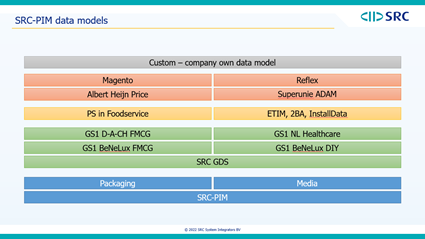Our PIM Experts love to share their passion for product information management and all the features, tips & tricks you might never have heard of. Our authors update you regularly with their knowledge in these ‘PIM Expert’ blogs, both accessible for the novice, and the professional PIM user. Today, we dive deeper into the available data models in SRC-PIM.
The data models that are used in SRC-PIM are the backbone of the application and determine how the application can be used. There are several data model types available in SRC-PIM. There are data models available that are provided by SRC. These models are also maintained by SRC and are updated regularly. These data models can be divided into different categories.

- Base data models
These are the data models that you always need to be able to use SRC-PIM. It includes data models like “SRC-PIM”, “Packaging” and “SRC Media”. - GDSN data models
There are several GDSN data models available. The base “GDS” data model is always needed when you would like to use GDSN. This “GDS” data model contains all views, attributes, code lists and validations that are defined in the global GDSN standard. Besides the base “GDS” data model, additional data models like “GS1 Benelux FMCG”, “GS1 Benelux DIY”, “GS1 Healthcare” and “GS1 DE FMCG” are available. These add-on data models contain additional views, attributes and validations for specific markets. - Other data models for communication with non-GDSN/GS1 data pools.
You can also use SRC-PIM to synchronize data with non-GDSN/GS1 data pools. Available options are:
- PS in Foodservice. This data model can be used to both retrieve item data (as retailer) from PS in Foodservice and send item data (as supplier) to PS in Foodservice.
- ETIM, 2BA, InstallData. These data models contain the ETIM data model as basis. For 2BA and InstallData there are additional attributes available. With this data model you can send data (as supplier) to 2BA (for The Netherlands) or to InstallData (for Belgium).
- PS in Foodservice. This data model can be used to both retrieve item data (as retailer) from PS in Foodservice and send item data (as supplier) to PS in Foodservice.
- Other data models
There are a number of other data models available that exist in the set of SRC-PIM standard data models. Below you find an overview of the available options.
- Albert Heijn Price. With this data model you can store price and other item data specifically for Albert Heijn. You can synchronize the item data as Albert Heijn Excel Sheet format and automatically deliver the data at Albert Heijn via e-mail.
- Magento. This data model contains the attributes for item data within Magento. It allows you to maintain the item data in SRC-PIM and synchronize to your Magento implementation.
- Reflex. This data model contains the attribute of the Reflex ERP system. It allows you to synchronize item data from Reflex to SRC-PIM. Within SRC-PIM you can view the data and forward it to for example a GS1 or PS in Foodservice data model.
- Superunie ADAM validations. This data model contains the Superunie specific validation that are part of the Superunie ADAM system. This allows you to activate the validations on the items data and see if the items are complete according to the Superunie standard before synchronizing the data to GS1.
Besides these SRC-PIM standard data models a company can create its own data model. This custom data model can be stand-alone or an add-on to one of the standard data models mentioned above. We will discuss the usage of custom data models in the next PIM expert blog.
If you would like to know more about data models and how you can use them to your organizations’ benefit, please contact our support team, PIM consultants, or your SRC account manager through sales@src.nl.
- Albert Heijn Price. With this data model you can store price and other item data specifically for Albert Heijn. You can synchronize the item data as Albert Heijn Excel Sheet format and automatically deliver the data at Albert Heijn via e-mail.